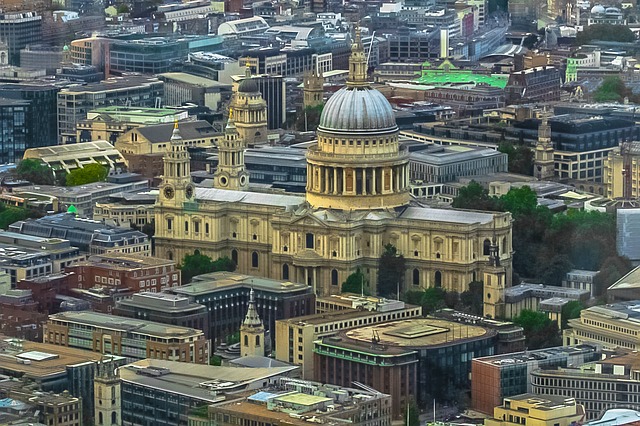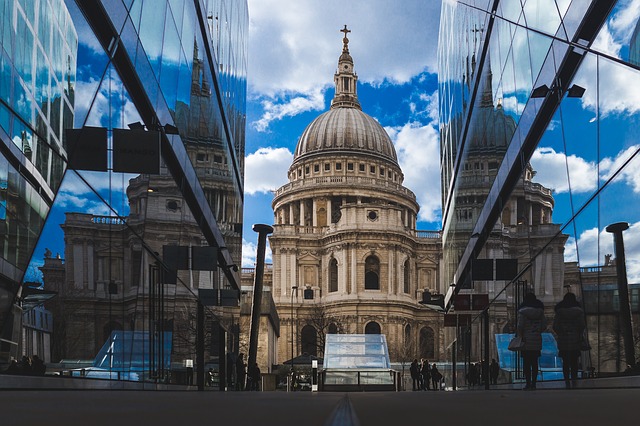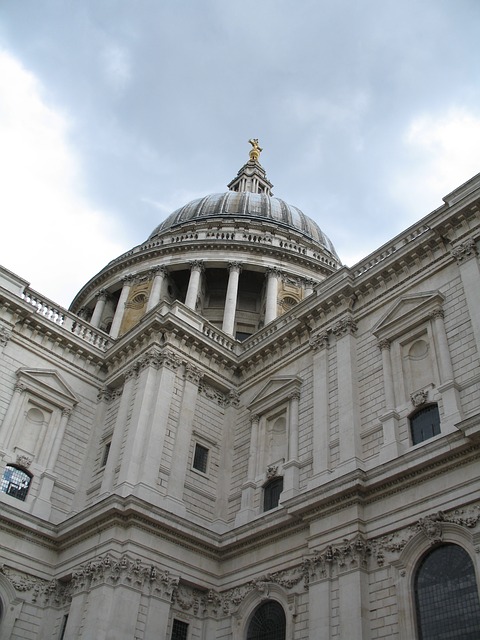St Pauls Cathedral
Contents |
[edit] Introduction
St. Paul’s Cathedral, designed by the architect Sir Christopher Wren, is an Anglican cathedral and one of London’s most iconic buildings. It is located on top of Ludgate Hill, the highest point in the City of London. Its famous lead-covered dome is one of the world’s largest, and at 111 m (365 ft), it was the tallest building in London from its completion in 1710 until 1967.
The current cathedral is the fifth building on the site of Ludgate Hill, the original church having been founded in 604 AD. The fourth, Old St. Paul’s was a huge Gothic cathedral built by the Normans and regarded as one of the masterpieces of medieval Europe, with a tower and spire reaching a height of 489 ft. It was destroyed by the Great Fire of 1666, following which, a decision was taken to build a new cathedral from scratch. The new cathedral was then pierced by a Nazi bomb in 1940, destroying the dome, which was reconstructed later.
St. Paul’s is one of the most significant buildings in terms of national identity, with propaganda images showing it remaining unscathed having become synonymous with the wartime Blitz. It has also been the location for the funerals of Lord Nelson, the Duke of Wellington and Sir Winston Churchill; as well as the wedding of Prince Charles and Lady Diana.
[edit] Design and construction
St. Paul’s was one of more than fifty church commissions that Sir Christopher Wren received in the aftermath of the Great Fire. He was tasked with creating a cathedral that was a fitting replacement of the Old St. Paul’s, and a suitable place of worship.
Wren was inspired by contemporary Renaissance trends in Italian architecture, and designed the cathedral in a restrained Baroque style, attempting to combine the traditions of English medieval cathedrals with the classical style of Inigo Jones, and French buildings by Mansart. The cathedral, in particular the dome, is heavily influenced by St. Peter’s Basilica in Rome.
He designed the showpiece west façade to be fronted by a wide flight of steps, a double-storey portico and two Baroque towers.
St. Paul’s is unusual among cathedrals in that it has a crypt which extends under the entire building rather than just under the eastern end. The crypt has a structural purpose, as massive piers spread the weight of the structure’s slimmer piers, necessary due to London’s relatively weak clay soil.
The most notable feature is the dome. To ensure the dome appeared visually satisfying when viewed both externally and internally, Wren designed a double-shelled dome, with the the inner and outer domes using catenary curves rather than hemispheres. Between the two shells, a brick cone supports the timbers of the outer, lead-covered dome, and the ornate stone lantern that rises above it. The cone and inner dome are 18 inches thick and supported by wrought iron chains to prevent spreading and cracking.
The dome rests on pendentives which rise between 8 arches spanning the nave, choir, transepts and aisles. It is raised on a tall drum around which there is a continuous colonnade.
The construction of the cathedral took more than 40 years, and was ‘topped out’ in 1708 by Christopher Wren Jr who placed the final stone on the lantern, watched by his father below.
[edit] Related articles on Designing Buildings
- After the Fire: London churches in the age of Wren, Hooke, Hawksmoor and Gibbs.
- Cathedral.
- Cathedral of Brasilia.
- Chapel of the Holy Cross, Sedona.
- Classical orders in architecture.
- Durham Cathedral's Open Treasure project.
- Eiffel Tower.
- Edinburgh Castle.
- Floors of the great medieval churches.
- Florence Cathedral.
- Georgian.
- Palace of Westminster.
- Pendentive dome.
- Sagrada Familia.
- St. Basil’s Cathedral.
- St Peters Basilica.
- Stuart architecture.
- Taj Mahal.
- The Rebuilding Acts.
- Types of dome.
- Unusual building design of the week.
[edit] External resources
- St Pauls - Official site
Featured articles and news
RTPI leader to become new CIOB Chief Executive Officer
Dr Victoria Hills MRTPI, FICE to take over after Caroline Gumble’s departure.
Social and affordable housing, a long term plan for delivery
The “Delivering a Decade of Renewal for Social and Affordable Housing” strategy sets out future path.
A change to adoptive architecture
Effects of global weather warming on architectural detailing, material choice and human interaction.
The proposed publicly owned and backed subsidiary of Homes England, to facilitate new homes.
How big is the problem and what can we do to mitigate the effects?
Overheating guidance and tools for building designers
A number of cool guides to help with the heat.
The UK's Modern Industrial Strategy: A 10 year plan
Previous consultation criticism, current key elements and general support with some persisting reservations.
Building Safety Regulator reforms
New roles, new staff and a new fast track service pave the way for a single construction regulator.
Architectural Technologist CPDs and Communications
CIAT CPD… and how you can do it!
Cooling centres and cool spaces
Managing extreme heat in cities by directing the public to places for heat stress relief and water sources.
Winter gardens: A brief history and warm variations
Extending the season with glass in different forms and terms.
Restoring Great Yarmouth's Winter Gardens
Transforming one of the least sustainable constructions imaginable.
Construction Skills Mission Board launch sector drive
Newly formed government and industry collaboration set strategy for recruiting an additional 100,000 construction workers a year.
New Architects Code comes into effect in September 2025
ARB Architects Code of Conduct and Practice available with ongoing consultation regarding guidance.
Welsh Skills Body (Medr) launches ambitious plan
The new skills body brings together funding and regulation of tertiary education and research for the devolved nation.
Paul Gandy FCIOB announced as next CIOB President
Former Tilbury Douglas CEO takes helm.
UK Infrastructure: A 10 Year Strategy. In brief with reactions
With the National Infrastructure and Service Transformation Authority (NISTA).

























